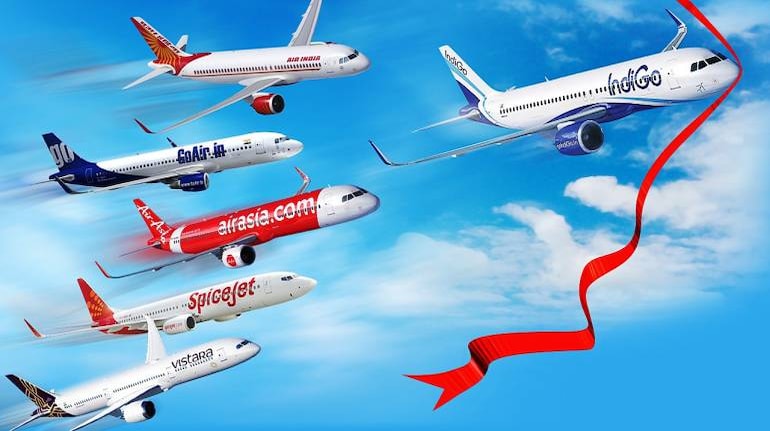



In the monthly statistics for domestic air traffic in India that are revealed every month, a long constant has been the leadership in market share. IndiGo, also the country’s largest carrier by fleet, has been the undisputed market leader by a distance for the past few years. A decade ago, while Jet Airways and Kingfisher Airlines were battling it out for the market share, with many months being neck and neck, IndiGo was slowly inching towards supremacy with its customary efficiency.
With the kind of war chest which IndiGo has built, the airline will definitely make it on the other side of the pandemic with only a few bruises.
That takes us to the others. The real battle in Indian skies is being played for the number two slot. And in a fragmented aviation market like India where making money is difficult due to intense competition, regulation and sometimes over-regulation, the number two position could potentially be a ticket to raising funds, getting more slots and much more.
Jet Airways was the clear number two until the end of 2018, the last full year when the airline operated. Jet and its subsidiary Jetlite had a market share of 15.5 percent with the third spot going to national carrier Air India, which had a 12.7 percent market share. Spicejet held on at number four with 12.3 percent.
But that changed quickly with the fall of Jet. By the end of Q1 of 2019, as Jet Airways started reducing its fleet, SpicJjet took the number two spot with a 13.6 percent market share, a percentage more than Air India. When Q2 ended, SpiceJet was at 14.5 percent and closed the year with a 14.9 percent market share, well clear of Air India and GoAir.
Where were we and where are we today?
The pandemic has changed the market dynamics. The year 2020 was full of nasty surprises, which included two months of a complete shutdown of commercial operations. Yet, the first full year after the fall of Jet Airways saw IndiGo end the year with over half the market share and SpiceJet corner 14.9 percent market share.
Market share is a factor of capacity share. Airlines deploying more capacity tend to get a higher market share.
With the capacity capped at 80 percent and the market conditions not right, only IndiGo has been deploying capacity closer to the upper cap with everybody else offering lower departures and thus a lower number of seats.
This has led to a sudden spurt in market share for IndiGo. The airline ended Q1 of 2021 with a 54 percent market share! Spicejet has slipped to 12.6 percent—the level it held in 2018. The consolation is that SpiceJet continues to be number two in the market.
How could the dynamics change?
That doesn’t mean the market will remain staid. National carrier Air India is up for sale. While the previous attempts have proved futile, there are reasons to believe that the sale would go through this time around.
While most airlines gained from the fall of Jet Airways, the sole loser has been Air India. The government did not invest in adding aircraft and with many of the aircraft grounded, the airline has not been able to add capacity.
It will all boil down to how the Tata group handles its aviation portfolio. The airline has already upped its stake in AirAsia India which now stands at over 80 percent with an option to buy out the remainder of the stake.
It already is a majority shareholder in Vistara, the joint venture with Singapore Airlines, at 51 percent. The pandemic has dealt a brutal blow on Singapore Airlines, which owns the remainder 49 percent. Will the Tatas also up the stake in Vistara?
Singapore Airlines has received a bailout from the government of Singapore. To add to this, if the group emerges as the winning bidder for Air India, all eyes will be on the decision it takes to maintain as many brands. As of today, for many months the market share of Vistara and AirAsia India either matches SpiceJet or exceeds a little.
The surprise package could be GoAir, which is preparing an umpteenth attempt to launch an IPO. The recent changes to the management could indicate the seriousness with which the Wadia group is looking at its airline venture. The airline has nearly 100 more aircraft which are to be delivered over the next few years.
Being second matters in more ways than one. A fragmented market share means that there is lesser presence in markets leading to the whole travel agent, OTA and other distribution channels option for the market leader.
Tail Note
Aviation is capital intensive and only IndiGo has a strong balance sheet right now. The Tatas with their commitment to the airline business and the strength of the group would be able to pump in more money while GoAir is looking to raise cash. SpiceJet has been holding its cards close to its chest.
The second half of 2021 will give a clear path ahead in Indian aviation and a lot of it depends on the direction which Air India sale takes.
Discover the latest Business News, Sensex, and Nifty updates. Obtain Personal Finance insights, tax queries, and expert opinions on Moneycontrol or download the Moneycontrol App to stay updated!